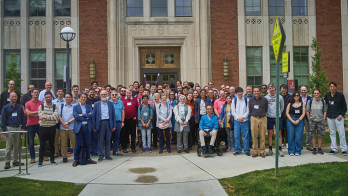The LHCb collaboration has made the first observation of the semileptonic baryon decay Λb0→ Λc+τ–ντ, and used it to carry out a new test of lepton-flavour universality. Presented on 10 January at the 30th Lepton Photon conference organised by the University of Manchester, the result brings a further tool to understand the flavour anomalies reported by LHCb and other experiments in recent years.
Lepton-flavour universality (LFU) is the principle that the weak interaction couples to electrons, muons and tau leptons equally. Decays of hadrons to electrons, muons and tau leptons are therefore predicted to occur at the same rate, once differences in the lepton masses are taken into account.

During the past few years, physicists have seen hints that some processes might not respect LFU. One of the strongest comes from b→cℓ–νℓ (ℓ=μ,τ) transitions in B-meson decays, as quantified by the parameter R(D∗), which measures the ratio of the branching fractions of B →D∗τ−ντ and B→D∗ℓ−νℓ. The combined deviation from precise Standard Model predictions of R(D*) and R(D) as measured by the BaBar, Belle and LHCb collaborations amounts to around 3.4σ. R(J/ψ), which concerns the branching ratios of Bc+→J/ψτ+ντ and Bc+→J/ψμ+νμ, was also found by LHCb to be larger than expected, but only at the level of around 2σ. Another key test of LFU involves the flavour-changing neutral current (FCNC) quark transition b→sℓ+ℓ–, for which several channels suggest that electrons are produced at a greater rate than muons. The largest effect comes from the decay B+→K+e+e–, for which LHCb finds R(K) to lie 3.1σ from the Standard Model expectation.
Taken individually, none of the measurements are significant. But together they present an intriguing pattern. New-physics models based on leptoquarks have been proposed as possible explanations for the anomalies observed in semileptonic B-meson decays and in FCNC reactions.
Baryons entered the fray in late 2019, when LHCb compared the rates of Λb0→pK–e+e– and Λb0→pK–μ+μ– decays. Although R(pK) also erred on the side of fewer muons than electrons, it was found to be in agreement with the Standard Model within the limited statistics. The latest LHCb analysis, which compared the branching ratio of Λb0→ Λc+τ–ντ from a sample of around 350 events selected from LHC Run 1 to that of Λb0→ Λc+μ– νμ measured by the former DELPHI experiment at LEP, found R(Λc+) = 0.242±0.026(stat)±0.040(syst)±0.059(ext), in good agreement (approximately 1σ ) with the Standard Model prediction of 0.324±0.004.
R(D*) can be large and R(Λc+) small in one new-physics scenario, or R(D*) large and R(Λc+) even larger in another
Guy Wormser
Baryon decays provide complementary constraints on potential violations of LFU to those from meson decays due to the different spin of the initial state. This allows constraints to be placed on possible new-physics scenarios, explains Guy Wormser of IJCLab, who led the LHCb analysis: “R(D*) can be large and R(Λc+) small in one new-physics scenario or R(D*) large and R(Λc+) even larger in another. The spin of the accompanying hadron changes the way new-physics couples into the reaction, and it depends also of the spin of particle present in the new-physics model, usually a leptoquark which can be a scalar, pseudoscalar, vector, axial vector or tensor. Our result excludes phase-space regions in some of these scenarios. In the future, a combined measurement of LFU violation — if it is confirmed — in mesons and baryons can therefore help to pin down the characteristics of the new-physics mediator.”
The latest LHCb result concerning R(Λc+) is likely to trigger intensive discussions among theorists, says the collaboration, with future measurements of this and other “R” measurements using Run-2 and Run-3 data keenly anticipated.
Further reading
LHCb collaboration 2022 arXiv:2201.03497.







